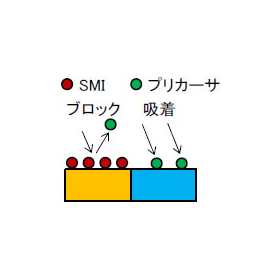[TEM-EDX] Energy Dispersive X-ray Spectroscopy
It is an analytical method for qualitative and quantitative analysis of organic compounds.
Gas chromatography (GC) is classified as a type of chromatographic method that utilizes differences in the adsorption or distribution coefficients of gases against a stationary phase to separate components. Gas chromatography-mass spectrometry (GC/MS) allows for the qualitative and quantitative analysis of components by using a mass spectrometer to detect the components separated by GC, based on mass information. - Effective for analyzing components with relatively low molecular weights and high volatility - Capable of qualitative and quantitative analysis of trace organic components - Various introduction methods can be selected according to the state of the sample and the purpose - A wide range of organic component structure estimation is possible due to a rich library
basic information
■Sample Introduction Gases or easily vaporized liquids can be directly introduced into the GC. For solids, depending on the analysis purpose, they are dissolved or vaporized using methods such as solvent extraction, pyrolysis, or headspace methods before being introduced into the GC. ■Component Separation The vaporized sample introduced into the sample introduction section is carried by the carrier gas and passes through the column. Due to the varying strengths of interactions with the stationary phase in the column, each component in the sample moves at different speeds, resulting in separation. ■Ionization (EI Method) The molecules of each component separated by the GC are sequentially introduced into the mass spectrometer, where they are ionized by colliding with thermal electrons emitted from a filament. Some of the generated ions (molecular ions) further fragment to produce fragment ions. ■Mass Separation (Quadrupole Type) The generated ions are introduced into a quadrupole mass spectrometer consisting of four rods. By adjusting the voltage applied to the rods, only ions of a specific mass reach the detector, resulting in a mass spectrum containing molecular mass information.
Price information
-
Delivery Time
Applications/Examples of results
- Structural analysis of polymers - Analysis of gas components released during heating - Composition analysis of gases within batteries - Odor analysis - Analysis of additives and impurities in resins - Analysis of residual solvents - Measurement of working environment - Analysis of environmental pollutants (such as VOC analysis)
Detailed information
-

Please consult with us first. ★ We will start with a proposal for an analysis plan ★ We can, of course, meet at your company for discussions. We will carefully explain the analysis results and leave no questions unanswered. Please contact us at 03-3749-2525 or info@mst.or.jp!
-

We will hold a visiting seminar. ★ We offer free seminars with engineers visiting to meet customer needs ★ We will introduce analysis techniques and explain analysis data according to your requests. ◆ Example seminar content - A broad explanation of MST analysis methods - A detailed explanation of specific analysis methods from the principles - Explanation of the analysis data requested by the customer Please contact us at 03-3749-2525 or info@mst.or.jp!
News about this product(2)
-

[MST Homepage] We have published a feature on environmental (air and odor) analysis.
"Unlike usual, there is a strange odor." "I want to know the components of the exhaust gases from the engine and pump." By identifying the source of the strange odor and determining its components, we can take measures smoothly. Moreover, as environmental issues gain attention, it is increasingly required to accurately understand what is actually emitted as exhaust gases from the equipment being used. This time, we will introduce our MST analysis service lineup using GC/MS to address the challenges of components in the atmosphere. **************************************** For more details, please visit the MST homepage and check out the special feature on environmental (atmospheric and odor) analysis!! ****************************************
-

[MST Homepage] Analysis Case Study 'Gas Emission Analysis and Polymer Material Identification Using Pyrolysis GC/MS' has been published.
The MST website has published analysis cases. ◆Title Gas Emission Analysis and Polymer Material Identification Using Pyrolysis GC/MS ~About the Principles and Applications of Pyrolysis GC/MS~ ◆Measurement Method / Processing Method GC/MS ◆Product Fields Lighting, Display, Cosmetics, Daily Necessities ◆Analysis Objectives Chemical Bond State Evaluation, Safety Testing, Thermal Property Evaluation ◆Overview Pyrolysis GC/MS is a gas chromatograph mass spectrometer equipped with a pyrolysis device in the sample introduction section. For polymer materials that previously required complex pretreatment, the sample can be heated using the pyrolysis device, allowing the gases generated to be introduced into the GC for analysis without pretreatment. Additionally, by varying the temperature conditions of the pyrolysis device and the sampling conditions (double-shot method), it is possible to obtain two different types of information separately, such as additives and polymer materials, from the same sample, making the analysis of unknown polymer materials easier. ★★For detailed data, please see the linked page★★
Recommended products
Distributors
MST is a foundation that provides contract analysis services. We possess various analytical instruments such as TEM, SIMS, and XRD to meet your analysis needs. Our knowledgeable sales representatives will propose appropriate analysis plans. We are also available for consultations at your company, of course. We have obtained ISO 9001 and ISO 27001 certifications. Please feel free to consult us for product development, identifying causes of defects, and patent investigations! MST will guide you to solutions for your "troubles"!



















































